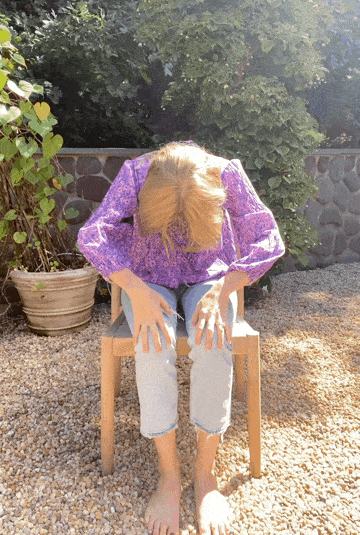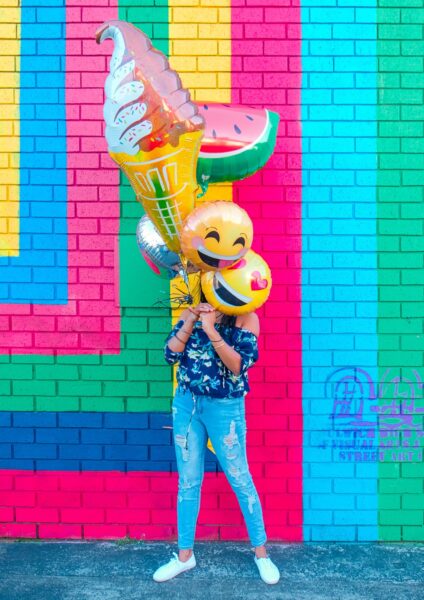A simple movement that can help you find joy

This week I taught the first session in the Reclaim Joy series, called How to Thrive in Tough Times. And can I just kvell for a sec? It was such a great group. Obviously, you know I love talking about joy, but getting together to dig into the complexity of our emotions, unearth hidden reservoirs of joy and resilience, and share ideas for building a more joyful life? It’s just heaven for me. (Note: If you missed it, the replay is available on demand, along with the 16-page workbook that walks you through every step of the process. Get more info here.)
In workshop sessions I like to do little breaks that help us transition from one activity to another while sharing a quick insight or tool you can use to find more joy. This is one of the breaks I shared during this week’s workshop.
A simple movement that can help you find joy
The movement
You probably know this movement already. It’s called seated cat-cow, and it’s a common pose in yoga classes. It’s a gentle pose that you can do seated in a chair or on the floor. You can also try it standing if that’s more comfortable for you. Make sure you feel settled and grounded, either with your feet flat on the floor or gently crossed. You can place your hands on your thighs or let them hang loose by your sides.
Note: As you do this, make sure to honor your body. Don’t do anything that’s painful or puts you at risk of injury. Let this be gentle.
The Cow
To start with, you’ll do the “cow” movement. Take a deep breath in and arch your back, elongating your spine. Let your shoulders open and your neck extend. You can look up toward the sky or ceiling if that’s comfortable for you, but be careful not to strain your neck.
The Cat
Then, when you’re ready to exhale, you’ll move into “cat.” As the breath flows out of you, round your spine, let your chin drop toward your chest and your tailbone roll under.
Do this a few times, and then try this: instead of arching back into cow, stay in cat pose and try to inhale.
What happens?
If you’re like most people, you might find it hard to take a deep breath. With your body tucked inward, it’s hard to expand with the breath.
Let that go, and allow your body to open back up and breathe in. Notice the difference?
We’re going to add more step here, and then I’ll break this down. I want you to add your arms to the movement. Let your arms fold in during cat, and then when you move into cow, let them open out in whatever way feels comfortable or natural to you. You can open them out to the side or up above in a Y shape. Whatever feels good to you. Do this three times, or more if you’d like!
Why it works
How do you feel after that?
Describing their experiences, workshop participants said things like “freeing,” “shifted my mood,” and “I needed that!” Why does this particular movement help us feel free, and what does that have to do with joy?
Charles Darwin was the first (to my knowledge) to observe that our posture changes with our emotions, just as our facial expressions do. In his book The Expression of the Emotions in Man and Animals, he observes the way the body straightens and expands in a state of joy. He writes, “A man in this state holds his body erect, his head upright, and his eyes open. There is no drooping of the features, and no contraction of the eyebrows… The whole expression of a man in good spirits is exactly the opposite of that of one suffering from sorrow.” Recent research affirms that “expansiveness” in body posture is consistently associated with joy. No surprise that this is the posture fans take when their team scores a winning goal, or that couples adopt when the officiant pronounces them officially married. It’s an expression of elation and release.
In an expansive shape, breath moves easily through us and it’s easier to move freely. Deep breathing can help activate the parasympathetic nervous system, which cues the body to relax and primes us for rest, connection, and play. Better breathing can also make you feel more energized. Lifting the head up increases what we can see in our peripheral vision, which makes us feel more open and connected to our surroundings. We also know that freedom is associated with joy, so it makes sense that feeling free in the body could help boost our mood.
But equally important is understanding the opposite state.
What happens when the body is constricted and tucked in?
If you look at an animal in a state of fear, you might notice that they tuck their tail, their head sinks into their shoulders, and their spine curls inward. These postural changes are adaptive: they make the animal small, so as to avoid detection or to appear unthreatening if noticed, and they protect vital organs by curling the body around them.
Humans don’t have a tail to tuck, but it turns out we do similar things when we feel anxious or threatened. We tuck our tailbone, which rounds the spine into a C-shape and pulls the head and shoulders into a forward slump. It’s not as extreme as a cat pose, but if you pay attention to it, you’ll notice that this posture feels noticeably constricted.
And here’s the thing: this posture isn’t just one we adopt when we’re anxious. Sitting at our desks and slouching over our phones draws the body into that C-shaped slump, one that takes the healthy curve (or lordosis) out of our lower spine, strains the neck, and as you saw in your cat pose, makes us take shorter, shallower breaths.
You may not be particularly stressed or anxious, but spending a lot of time in a constricted posture sends unconscious signals to the brain about how you’re feeling. At best, this can leave you feeling low energy and tight. At worst, it can make you feel pretty bummed out.
Taking just a few minutes to shift your posture and expand outward can help in a few ways. An expansive posture helps you reset your emotions, energize your body, and create a little more space to feel joy.
If you try this, let me know how it goes! I’d love to hear how it works for you.



Discussion (2 Comments)
Going to try this!
Yes! This is the same posture (cow, arms up in a Y) that feels so good to stretch to when getting out of bed in the morning!